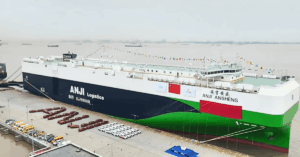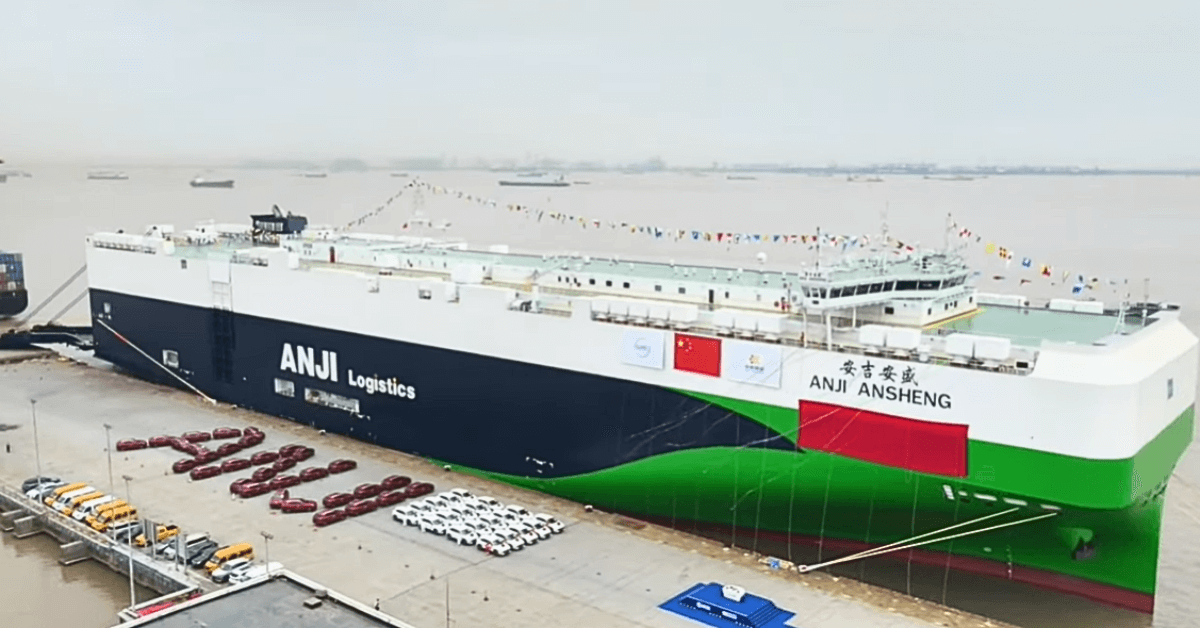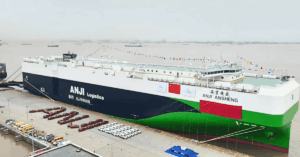
Poland Checks For Explosives Near Baltic Sea Cable After Russian Ship Encounter
May 23, 2025
Philippines Accuses China’s Coast Guard Of Intentionally Ramming Its Largest Cutter
May 23, 2025

China has delivered the world’s largest ocean-going car carrier, which set sail from Shanghai on May 22 loaded with approximately 7,000 China-made vehicles, mostly new energy cars, heading to Europe.
The vessel, Anji Ansheng, was built by SAIC Anji Logistics Ltd, a subsidiary of SAIC Motor Corporation. It measures 228 meters in length and 37.8 meters in width, and can carry up to 9,500 standard vehicles, the highest capacity of any car carrier globally.
With this, it has surpassed the previous record held by BYD Shenzhen, another Chinese-built ship launched just weeks earlier. According to Chinese public policy experts, this milestone shows the country’s resilience to foreign trade despite global uncertainties.
The Anji Ansheng is equipped with energy-saving features and intelligent low-carbon systems. It is designed for high energy efficiency and incorporates a methanol fuel reserve.
Executives at SAIC Anji Logistics mentioned that this vessel is just the beginning. The company plans to put seven more super-large car carriers into operation soon, aiming to cover more than 100 destinations worldwide, including Western Europe, Southeast Asia, the Middle East, and Mexico.
By 2026, SAIC’s ocean-going fleet is expected to grow to 22 vessels. Chinese automakers like BYD and Chery are rapidly expanding their presence in global markets.
For years, international car shipping was dominated by Japanese and South Korean firms, leading to high chartering costs and frequent delays for Chinese manufacturers.
To overcome this, SAIC has invested nearly 10 billion yuan (approximately $1.4 billion) in building a fleet of 12 ultra-large RoRo ships, each with a capacity of over 7,600 vehicles.
Company representatives believe this initiative could reduce per-vehicle export costs by around 10 per cent.
Experts in China say that owning ships helps keep logistics steady, reduces reliance on foreign carriers, and strengthens Chinese carmakers’ position in global markets.
Video Credits: New China TV/YouTube
BYD, one of the country’s top EV makers, delivered its fourth large car carrier, BYD Shenzhen, earlier this year in Jiangsu Province. The ship, capable of carrying over 9,000 vehicles, runs on both LNG and traditional marine fuels, reducing CO₂ emissions by approximately 23 per cent compared to older heavy-fuel oil ships.
It also includes photovoltaic energy storage systems that allow for zero-carbon emissions during loading and unloading.
BYD is on track to deliver its next RoRo vessel, BYD Xi’an, with a capacity of 9,200 vehicles by mid-year and aims to have all eight of its RoRo ships operating by the end of 2025. In the first quarter alone, its fleet transported more than 25,000 new energy vehicles overseas.
Meanwhile, Chery Automobile launched its first ocean-going car carrier in January and plans to deploy its second and third ships by mid-2025.
In another major development, China Merchants Energy Shipping Co, Ltd (CMES) successfully launched the world’s first methanol dual-fuel car carrier on May 21, 2025, at its Nantong shipyard.
This 219.9 meter long, 37.7 meter wide vessel, with a capacity of 9,300 vehicles, represents the largest methanol-powered RoRo ship currently under construction.
It meets IMO Tier III emission standards and uses methanol dual-fuel engines, auxiliary systems, boilers, and fuel supply systems.
The company has ordered six methanol dual-fuel PCTCs, two 9300 CEU ships and four 7,800 CEU ships, all to be delivered between 2025 and 2026. These are being built by China Merchants Heavy Industry.
China’s auto exports are rapidly growing. The General Administration of Customs of China reported that the country exported over 6.4 million vehicles in 2024, maintaining its position as the world’s largest auto exporter for the second consecutive year.
In the first four months of 2025 alone, China exported more than 1.93 million vehicles, marking a 6 per cent year-on-year increase.
References: english.gov.cn, cgtn
Source: Maritime Shipping News


